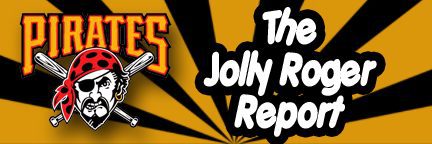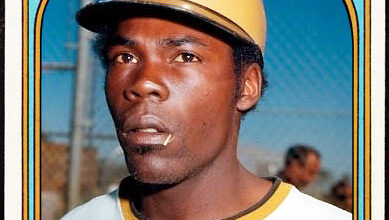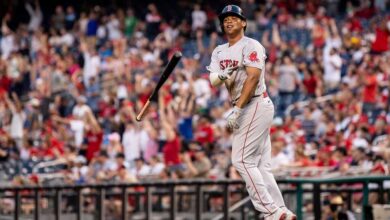
Despite a disastrous series against the Marlins — for those of you who shut the televisions off in disgust, the Buccos did score in the third game — there is still some hope for the Pirates this season. While this certainly isn’t the “Glee has to be cancelled this year, what a horrible show” type of hope, it is hope nonetheless. Let’s face it — after 18 years of little league ball being played on the shores of the Three Rivers, it’s about time that a season comes along that brings some optimism and excitement to the Steel City. It is Pittsburgh’s yearning for a winning ball club that brings me to my first topic in this inaugural edition of The Jolly Roger Report.
The Pirates are the next Penguins?
No, it’s not crazy. There are some scary similarities between the two franchises — the main difference being that the Penguins are a few years ahead of the Pirates in terms of progress. Let’s break down some of these similarities a bit.

First, the Penguins had planned on building their early franchise on Michel Briere, choosing him 26th in the 1969 NHL Draft. He soon became the leading rookie scorer in the league and was drawing comparisons to the greats of Phil Esposito and Bobby Clarke. That is no small order. In his first season, he created what is remembered as one of the most pivotal moments in the franchise of the Penguins — scoring the overtime goal in the opening round of the playoffs to mark Pittsburgh’s first playoff series win in California. Hope was high in Pittsburgh. A true superstar in the making had joined the Penguins’ family.
Just days after his playoff antics, Briere was put into a coma after suffering severe head trauma in a car crash. Dying a year later, the city of Pittsburgh was left to mourn and wonder “what if?” How does this tie into the Pittsburgh Pirates? I’m going to leave the storytelling up to you, but provide the subject. Roberto Clemente. While the death of Clemente certainly wasn’t the end of success for the Pirates by any stretch of the imagination, it still put Pittsburgh fans into a deep mourning state. A true beacon of excellence was lost. With both Clemente and Briere.
After losing Briere, the Penguins went into what I like consider the first “Dark Age.” Even after acquiring Mario “The Real Great One” Lemiux (Gretzky who?) in the 1984 Entry Draft, the Penguins were still so riddled with shoddy lines that Lemuix literally had no help. It was a one-man army. It wasn’t until the late ’80s that the Penguins’ front office beefed up the lines from top to bottom, thus propelling the Penguins from cellar dweller to immediate playoff contender. To make a long story short, we all know what happened next. Lemuix. Jagr. Barrasso. Stanley Cups. Success. And then it all ended. After all the years of building all-star quality lines and winning Lord Stanley, the Penguins had run up a debt that would make even George Bush blush — $90 million. In terms of professional hockey, that is a nice chuck of change. After purchasing the team, and flirting with leaving Pittsburgh, Lemuix brought the team back from the brink. And this is where the similarities begin with the Pirates — again.
We all know that the Pirates are in an 18-year “Dark Age” of their own. Fortunately, they seem to be following the model set up by the Penguins. First came Marc-Andre Fleury. Then Evgeni Malkin. Then Sidney Crosby. The Penguins learned, in order to be successful both on and off the ice, that youth was the answer. By bringing in top-quality players through the drafts, the Penguins built excitement in Pittsburgh again. Ticket sales hit all-time highs. The Pirates need to watch, learn and take action. As of now, I’m comfortable in saying that the Buccos are doing an “okay” job in terms of simulating the rebuilding process the Penguins used. A lot of young talent can be found throughout the entire Pittsburgh organization. Is any of it going to produce in the majors? If they do, will they be wearing a Pirate uniform? Who knows? But, point in case, the Pirates’ rebuilding process is eerily similar to that of the Penguins. While Brandon Wood or Andrew McCutcheon may not exactly be the same caliber of the likes of Crosby and Malkin, it shows that the Pirates are buying into the Penguins’ idea of building a franchise. Us Pirate fans can only hope they replicate the success of the Penguins in coming years. The mention of Brandon Wood brings up our next topic of conversation …

Bring The Wood
Remember this line from Major League Baseball: “You may run like Hayes … but you hit like shit.” I often think about Clint Hurdle delivering that line to Ronny Cedeno, except it goes like this: “You may run like Cedeno … oh, who am I kidding. You suck.” Unfortunately, Hurlde seems like he is too nice of a guy to tell a major league baseball player that he is about as useful as, I don’t know, the NBA? Seriously, the guy is a waste of space. I was hoping that the signing of Wood would immediately remove Cedeno from the line up. Unfortunately, Sunday’s game featured more of Cedeno at shortstop and more mediocre play (that is, one hit with one RBI). Despite reports confirming that Wood was dressed and ready to go, he never saw the field. I can only hope that he makes an appearance in the upcoming home series against the Giants.
However, the potential impact that Wood may bring to the offense/defense shouldn’t be the real story here. What should it be? The fact that Neal Huntington was willing to acquire him from waivers. As Pirates fans, we have become accustomed to the management passing up on sure draft picks (Cole Hamels, B.J. Upton and Prince Fielder in 2002!). Further, we have watched as some solid prospects grew in the system, showed great potential and were just as quickly traded away for head-scratching acquisitions. I know that it may not seem like much, but the addition of Wood is positive on two fronts. Gameplay and management. I pray (just as hard as I pray for the return of Surge) that Huntington keeps up this attitude. It only further confirms that the Pirates are mimicking, maybe even unknowingly, the rebuilding plan of the Penguins from years ago.
Until next time … There it is. The first-ever Jolly Roger Report. They’ll get better with time, I promise. Kind of like Pamela Anderson. Or Seinfeld. See you next week.






